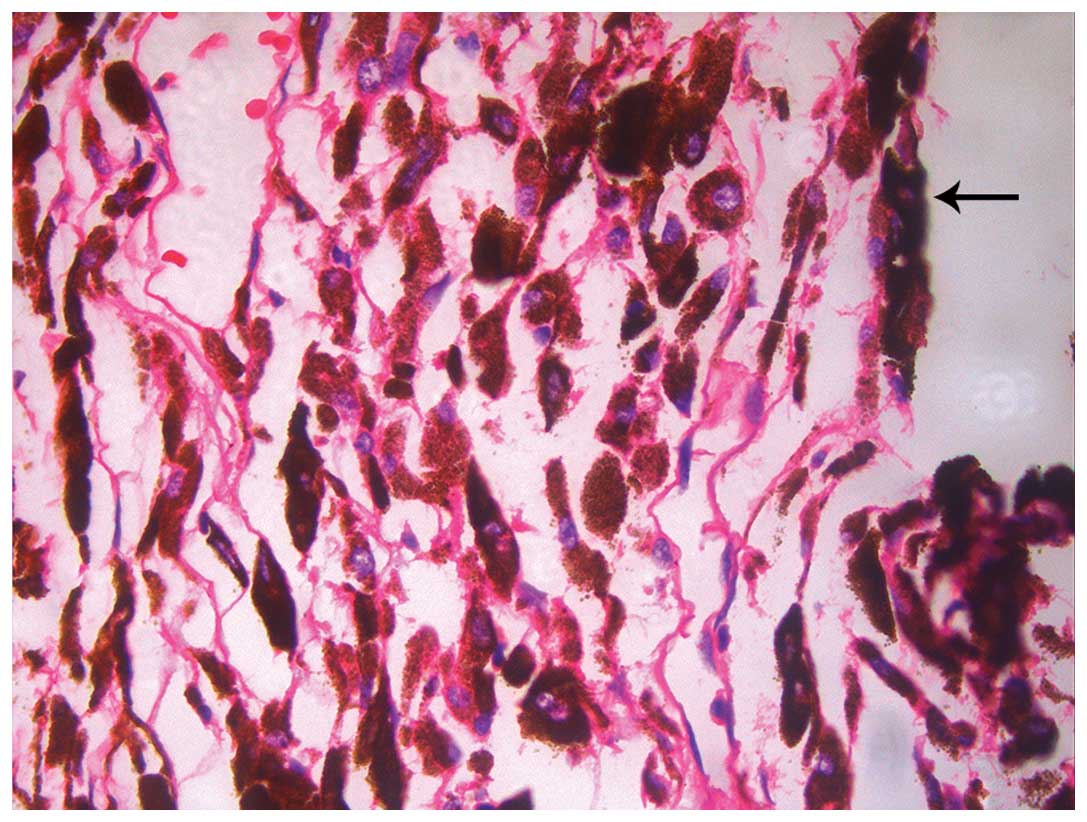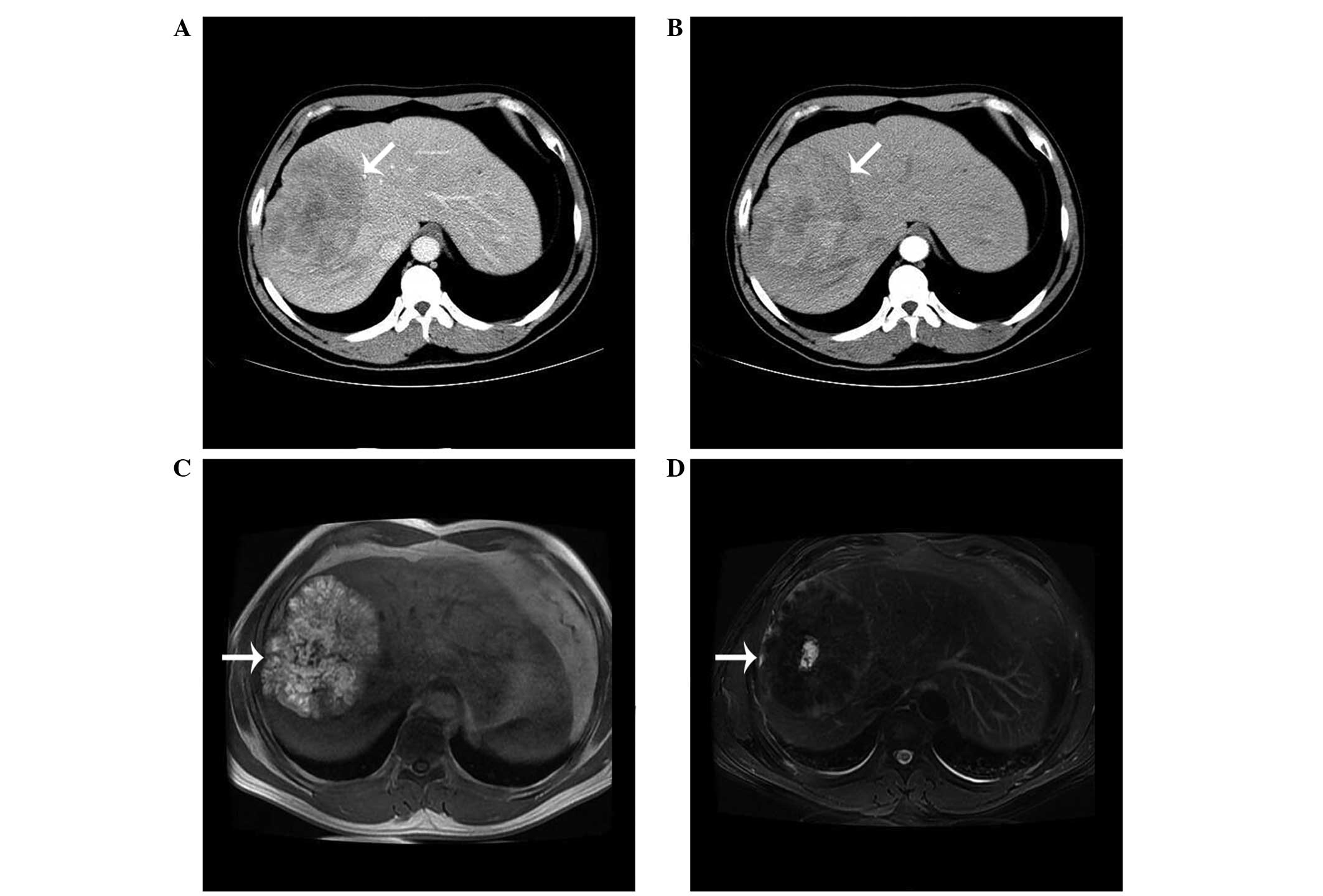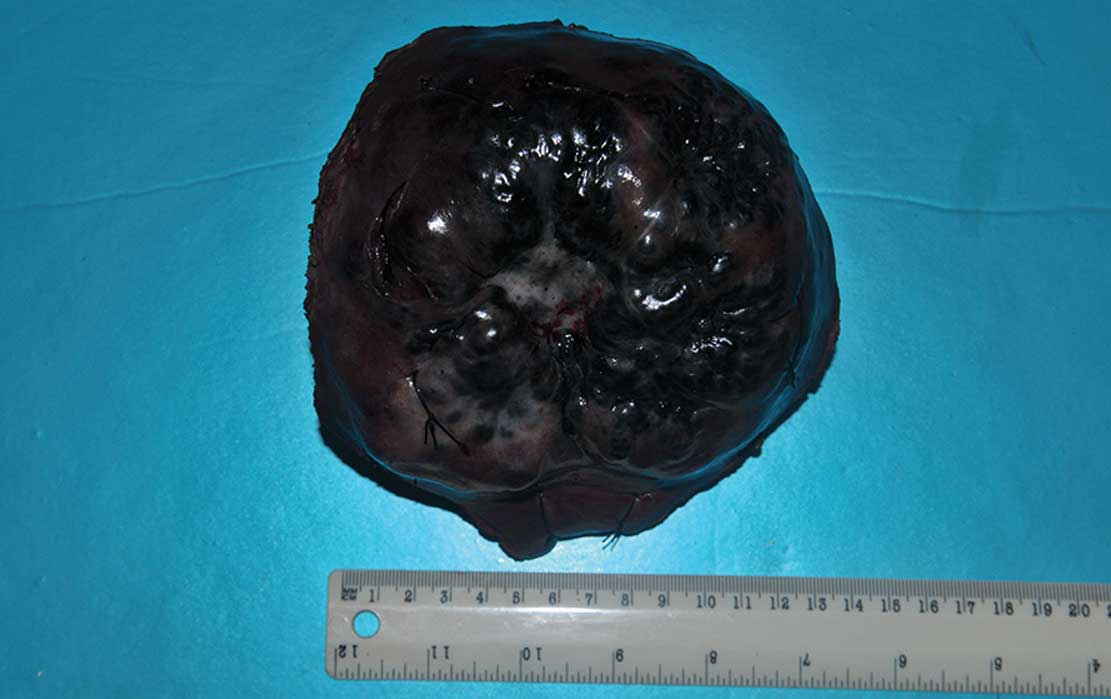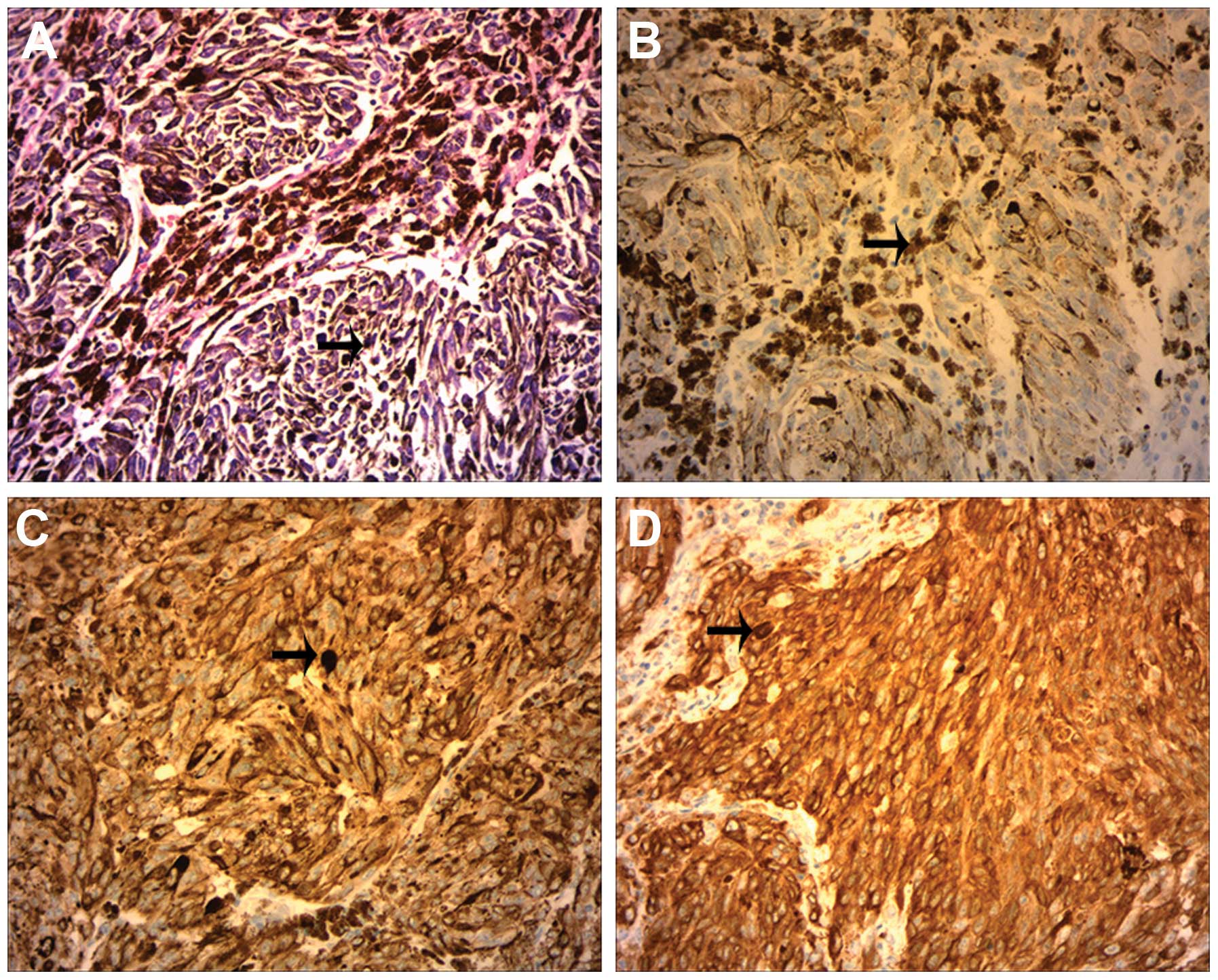Complete resection of isolated hepatic metastatic uveal melanoma with a notably long disease-free period: A case report and review of the literature
- Authors:
- Published online on: May 18, 2015 https://doi.org/10.3892/ol.2015.3217
- Pages: 196-200
-
Copyright: © Lin et al. This is an open access article distributed under the terms of Creative Commons Attribution License.
Abstract
Introduction
In western countries, the reported incidence of uveal melanoma is ~7 cases per million population per year. In China, the incidence of the disease is much lower (1,2). Due to its unique biological properties and the lack of diagnostic techniques in its early stage, 40% of choroidal melanoma cases present with metastases at diagnosis. The most frequently affected organ is the liver (93–95% of cases), due to the higher blood flow and a paucity of lymphatics in the choroid (3). Metastasis usually occurs in the majority of patients within 5 years of treatment of a primary lesion. Upon the occurrence of liver metastases, the lesions are frequently multiple, distributed and difficult to resect surgically (4–6). More than 90% of patients succumb within 1 year, and even with aggressive treatment strategies, the median survival time of patients with liver metastases is less than 13 months (7–9). Furthermore, a few cases of spontaneous rupture of metastatic hepatic melanoma have been reported (10–12). However, surgeons do not often attach significance to the risk of bleeding caused by spontaneous rupture of metastatic melanoma, which causes difficulties in the timely rescue if the tumor ruptures.
Here, we report an extremely rare case of metastatic melanoma following the treatment of primary ocular lesions, which is relatively unusual for two reasons: firstly, a solitary hepatic metastasis with spontaneous rupture is extremely rare; secondly, the exceptionally long disease-free period (10 years) with this mode of metastasis is also rare. This case emphasizes the need for clinicians to pay attention to the presence of ruptured hepatic metastatic melanoma and the characteristics of metastatic melanoma.
Case report
Patient characteristics
On December 3, 2013, a 45-year-old Chinese male was referred to the First Affiliated Hospital of Zhejiang University (Hangzhou, China), with complaints of bloating for a month. Ten years earlier, the patient had undergone left ocular enucleation and artificial eye implantation at a different hospital. Postoperative pathology revealed choroidal melanoma without intrascleral or vascular involvement (Fig. 1). On December 22, 2013, right hepatectomy was performed for the purposes of diagnosis and cure. The patient was scheduled for abdominal ultrasonography and a liver function test 1 month after surgery; however, the patient's treatment was delayed until 2 weeks after the scheduled date due to the Chinese Spring Festival. On examination, isolated pancreatic recurrence was observed. Distal pancreatic resection and splenectomy were performed on February 5, 2014. Until now, no symptoms of recurrence have been observed in our patient. The study was approved by the Ethics Committee of the First Affiliated Hospital of Zhejiang University. Written informed consent was obtained from the patient's family.
Imaging examinations
Abdominal magnetic resonance imaging (MRI) was performed using Magneton Impact 3.0T operating on the Numaris VB33D imaging system (Philips, Veenpluis, Netherlands), and transverse and sagittal T1-weighted and T2-weighted images were examined. Gadopentetate dimeglumine (Magnevist; Shering, Berlin, Germany) was intravenously administered at a dose of 0.1 mmol/kg of body weight, and contrast-enhanced images were obtained immediately. An abdominal computed tomography (CT) scan was performed using a Brilliance 64-channel scanner (Philips). For enhanced CT, 30 ml iohexol (GE Healthcare, Carrigtwohill, Ireland) was administered via intravenous drip infusion, and images were obtained. For computed tomography angiography (CTA) images, 50 ml iobitridol (Guerbet, Villepinte, France) was administered via intravenous drip infusion. Positron emission tomography (PET-CT) was performed by injection of F-18-fluoro-2-deoxyglucose (FDG) at a dose of 7 mCi (calculated by 0.1 mCi/kg). Full-body PET-CT scans were performed from the top of the head to the bottom of the feet. The CT portion was carried out using a multi-detector helical computed tomography scanner (Philips).
Histological examination
The paraffin-embedded tumor tissue sections were stained immunohistochemically with optimally diluted primary antibodies and appropriate antigen retrieval solutions. The Histofine SAB-PO (M) or (R) immunohistochemical staining kit (Nichirei, Tokyo, Japan) was used. The primary antibodies used were anti-S100 protein (rabbit polyclonal; Dako, Glostrup, Denmark), anti-HMB45 protein (rabbit polyclonal; Dako), anti-Melan A protein (mouse polyclonal; Dako) and anti-α-fetoprotein (AFP; mouse polyclonal; Dako).
Surgery
The protocol of surgical resection was decided together by the patient and the treatment team in various departments including those of Hepatobiliary Surgery, Radiology and Chemotherapy. The effect of surgery was assessed using the following standards: R0, negative microscopic margins; R1, positive microscopic margin; and R2, gross residual disease. To begin, the surgical team made a roof-shaped incision under the bilateral costal margin from the front tip of the 11th rib in order to fully expose the visual operative field. In the next step, the ligamentum teres hepatic and falciform ligament was disconnected, and the whole liver and the lesion were exposed clearly. Then R0 lesion resection was performed following careful dissociation of the common bile duct, hepatic artery and portal vein. Finally, bleeding was stopped by using the meticulous hemostatic technique, a drainage catheter was put in place and the abdominal cavity was closed.
Imaging findings
Abdominal CT scan and MRI (Fig. 2) revealed a 12×13 cm mass in the right liver. In the CT arterial phase, a mild heterogeneous enhanced signal revealed that the mass in the right liver may be a hepatic tumor. T1-weighted imaging revealed a peripheral high signal and a low heterogeneous signal. T2-weighted imaging revealed a center-enhanced mass with a low signal edge. Hepatic CTA revealed no abnormal vessels that might be considered as possible tumor vessels, and the huge mass had partially ruptured and was bleeding spontaneously. The whole liver volume was 2,428 cm3, and the left liver volume was 450 cm3. PET-CT revealed a solitary huge nodule with increased FDG uptake in the right liver.
Surgery and immunohistochemical findings
Radical right hepatectomy was performed on December 22, 2013. Rapid histological examination during surgery revealed malignant hepatic metastatic melanoma. A macroscopic view of the tumor is shown in Fig. 3. The hard protruding mass on the liver has a size of ~11×10 cm and an irregular boundary with a sunken central white area, which was regarded as an indication of spontaneous intratumoral hemorrhage and necrosis. The diagnosis of malignant hepatic metastatic melanoma was made after the results of detailed histopathological examination were confirmed: HMB45(+), S100(+), AFP(–) and Melan A(+) (Fig. 4). One-and-a-half months after surgery, an isolated pancreatic lesion was identified by abdominal MRI scan (Fig. 5). Distal pancreatic resection and splenectomy were performed. Postoperative immunohistochemistry also confirmed melanoma metastasis: HMB45(+), S100(–), AFP(–) and Melan A(+).
Discussion
In recent years, melanoma has caused wide public concern due to the rapid increase of its incidence, in addition to its highly malignant and metastatic characteristics. Although the incidence of melanoma in China is currently relatively low compared with that in European and American countries, new cases of melanoma have been reported at a notable rate of almost 20,000 new cases a year (1). In western countries, the reported incidence of uveal melanoma is ~7 cases per million population per year. Most patients present with localized disease and can expect a 5-year survival rate of 82–87% if they are younger than 60 years (2,13). Kivelä et al (3) suggested that tumor micrometastases develop as long as 5 years before the local ocular therapy, and the most frequently affected organ is the liver (93–95% of cases) due to the higher blood flow and paucity of lymphatics in the choroid. However, Miyamoto et al (14) considered that if the dissemination of the primary tumor occurs through a hematogenous route, then the cells that escape from the primary tumor should first encounter the capillary beds of the lungs. These authors therefore concluded that the reason why the liver is the main site of uveal melanoma metastasis is a combination of two factors: the reflection of the homing of tumor cells to this organ and the survival of these uveal melanoma cells in the liver microenvironment. In recent years, literature has indicated that histological, genetic and demographic factors are associated with metastases in uveal melanoma, including mutations in genes GNAQ, GNA11 and PTEN, the helix-loop-helix inhibitor ID2, chromosome 3, 6 and 8 alteration, miRNA-21, and mutations in c-Kit and BRAF (15–17).
Rajpal et al (18) revealed that approximately two-thirds of patients present with metastatic disease less than 5 years after initial diagnosis by analyzing the samples of 35 patients. In a retrospective study at Duke University, only 168 patients out of 7,104 patients with diagnosed uveal melanoma had recurrence 10 or more years after initial diagnosis, indicating an incidence of 2.4% (19). Pons et al (20) analyzed a total of 58 patients and demonstrated that the median time for metastases development was 25.63 months. A systematic review revealed that metastases to the liver occurred at a median interval of 54 months (21). Moreover, Yang et al (4) identified that 75% of Chinese patients presented with liver metastases at the time the primary tumor was diagnosed in a retrospective single-center analysis. In our patient, melanoma recurrence occurred a decade after treatment of the original tumor, which can be counted as a relatively rare case.
Once liver metastasis occurs, the lesions are often multiple, distributed and difficult to resect surgically (6). More than 90% of patients succumb within 1 year, and patients are considered resistant to commonly available systemic chemotherapy or chemoimmunotherapy, with single-agent response rates below 10%. Even with aggressive treatment strategies, the median survival time of patients with liver metastases is less than 13 months (7–9). A detailed review of uveal melanoma has revealed that liver function tests, serum markers including alkaline phosphatase and lactate dehydrogenase, and imaging screening including abdominal ultrasound, CT, MRI and PET-CT contribute to the early detection of melanoma metastasis (13). Triozzi and Singh (22) also reviewed blood biomarkers of uveal melanoma metastasis covering vascular endothelial growth factor, hepatocyte growth factor, epidermal growth factor and insulin-like growth factor-1. However, Augsburger et al (23) reported that there is no significant decisive evidence that early detection of metastatic disease impacts survival. Active surveillance might become widely accepted if these interventions are associated with a lower disease burden (15).
The modern multidisciplinary management of melanoma metastases to the liver has evolved greatly in recent years. Vahrmeijer et al (24) described the various treatment modalities of uveal melanoma metastases confined to the liver in a review, suggesting that regional treatment modalities including hepatic artery infusion, isolated hepatic perfusion and hepatic arterial chemoembolization may be considered in order to increase the response rate. Mariani et al (25) undertook a detailed retrospective review of 3,873 patients with uveal melanoma and concluded that surgical resection is able to offer a greatly improved long-term survival and appears at present to be the optimal way of improving the prognosis in metastatic uveal melanoma. A further meta-analysis further elaborates that radical resection (R0 resection) of liver metastases from melanoma appears to improve overall survival compared with non-operative management or incomplete resection. Data from this review indicates that the presence of multiple lesions involving one viscera is not a contraindication to surgical therapy if R0 resection is achievable (26). However, in the majority of patients, hepatectomy is impossible due to the extent or location of metastatic melanoma (4). A noteworthy study by Zhao et al (27) reported a case of adult-to-adult living donor liver transplantation as a treatment option for metastatic melanoma. Although the high recurrence rate and probable poor prognosis of this malignant tumor make transplantation controversial, we remain of the opinion that this new treatment option should be provided.
In addition, a few cases of spontaneous rupture of metastatic hepatic melanoma have been reported (10–12), but the pathogenesis and treatment modalities have not been determined. You et al (28) considered that tumor protrusion >1 cm above the liver surface is a significant independent risk factor for spontaneous rupture of hepatocellular carcinoma by retrospectively analyzing a sample of 34 patients. We considered that the situation in our case was likely to be similar to that of ruptured hepatocellular carcinoma. Chun et al (10) suggested that transcatheter arterial embolization would be an effective, safe treatment in patients with rupture of metastatic hepatic melanoma. In our case, the CTA image of the patient revealed that the huge mass had partially ruptured and was bleeding spontaneously; hemostatic drugs were given to relieve bleeding. However, surgeons do not often attach significance to the risk of bleeding caused by spontaneous rupture of metastatic melanoma, which naturally makes timely rescue more complicated.
In conclusion, surgery is a feasible and effective method for only a small number of patients. When surgery cannot be performed to remove the lesion, it remains unclear which type of adjuvant therapy is the most conducive to the patient. Since the total number of cases of melanoma with liver metastases is low, and large-sample multi-center double-blind randomized controlled trials are lacking, opinions on the optimal treatment of liver metastatic melanoma are not yet unified. Our case is quite unusual in two respects: firstly, a solitary hepatic metastasis with spontaneous rupture is extremely rare; secondly, the exceptionally long disease-free period (10 years) with this mode of metastasis is also rare. This case emphasizes the need for clinicians to pay attention to the presence of ruptured hepatic metastatic melanoma and the characteristics of metastatic melanoma.
Acknowledgements
The authors would like to thank the staff of the Departments of Hepato-Biliary-Pancreatic Surgery, Pathology and Radiology in the First Affiliated Hospital of Zhejiang University Medicine School for their helpful assistance.
References
|
Committee of Experts of the Chinese Society of Clinical Oncology for Melanoma, . China melanoma treatment guidelines (2011). Chin Clin Oncol. 159–171. 2012. | |
|
Balch CM, Soong SJ, Gershenwald JE, et al: Prognostic factors analysis of 17,600 melanoma patients: validation of the American Joint Committee on Cancer melanoma staging system. J Clin Oncol. 19:3622–3634. 2001.PubMed/NCBI | |
|
Kivelä T, Eskelin S, Mäkitie T and Summanen P: Exudative retinal detachment from malignant uveal melanoma: predictors and prognostic significance. Invest Ophthalmol Vis Sci. 42:2085–2093. 2001.PubMed/NCBI | |
|
Yang XY, Xie F, Tao R, Li AJ and Wu MC: Treatment of liver metastases from uveal melanoma: a retrospective single-center analysis. Hepatobiliary Pancreat Dis Int. 12:602–606. 2013. View Article : Google Scholar : PubMed/NCBI | |
|
Rivoire M, Kodjikian L, Baldo S, Kaemmerlen P, Négrier S and Grange JD: Treatment of liver metastases from uveal melanoma. Ann Surg Oncol. 12:422–428. 2005. View Article : Google Scholar : PubMed/NCBI | |
|
Rietschel P, Panageas KS, Hanlon C, Patel A, Abramson DH and Chapman PB: Variates of survival in metastatic uveal melanoma. J Clin Oncol. 23:8076–8080. 2005. View Article : Google Scholar : PubMed/NCBI | |
|
Varghese S, Xu H, Bartlett D, et al: Isolated hepatic perfusion with high-dose melphalan results in immediate alterations in tumor gene expression in patients with metastatic ocular melanoma. Ann Surg Oncol. 17:1870–1877. 2010. View Article : Google Scholar : PubMed/NCBI | |
|
Peters S, Voelter V, Zografos L, et al: Intra-arterial hepatic fotemustine for the treatment of liver metastases from uveal melanoma: experience in 101 patients. Ann Oncol. 17:578–583. 2006. View Article : Google Scholar : PubMed/NCBI | |
|
Rubio S, Barbero-Villares A, Reina T, Nieto S, Mendoza J and García-Buey L: Rapidly-progressive liver failure secondary to melanoma infiltration. Gastroenterol Hepatol. 28:619–621. 2005. View Article : Google Scholar : PubMed/NCBI | |
|
Chun HJ, Osuga K, Fahrni M and Nakamura H: Massive bleeding of ruptured metastatic hepatic melanoma treated by transarterial embolization. Jpn J Radiol. 28:395–397. 2010. View Article : Google Scholar : PubMed/NCBI | |
|
Wagner WH, Lundell CJ and Donovan AJ: Percutaneous angiographic embolization for hepatic arterial hemorrhage. Arch Surg. 120:1241–1249. 1985. View Article : Google Scholar : PubMed/NCBI | |
|
Cooperman AM, Weiland LH and Welch JS: Massive bleeding from a ruptured metastatic hepatic melanoma treated by hepatic lobectomy. Case report and review of the literature. Mayo Clin Proc. 51:167–170. 1976.PubMed/NCBI | |
|
Papastefanou VP and Cohen VM: Uveal melanoma. J Skin Cancer. 2011:5739742011. View Article : Google Scholar : PubMed/NCBI | |
|
Miyamoto C, Balazsi M, Bakalian S, Fernandes BF and Burnier MN Jr: Uveal melanoma: Ocular and systemic disease. Saudi J Ophthalmol. 26:145–149. 2012. View Article : Google Scholar : PubMed/NCBI | |
|
Materin MA, Faries M and Kluger HM: Molecular alternations in uveal melanoma. Curr Probl Cancer. 35:211–224. 2011. View Article : Google Scholar : PubMed/NCBI | |
|
Yang C and Wei W: The miRNA expression profile of the uveal melanoma. Sci China Life Sci. 54:351–358. 2011. View Article : Google Scholar : PubMed/NCBI | |
|
Sisley K, Doherty R and Cross NA: What hope for the future? GNAQ and uveal melanoma. Br J Ophthalmol. 95:620–623. 2011. View Article : Google Scholar : PubMed/NCBI | |
|
Rajpal S, Moore R and Karakousis CP: Survival in metastatic ocular melanoma. Cancer. 52:334–336. 1983. View Article : Google Scholar : PubMed/NCBI | |
|
Crowley NJ and Seigler HF: Late recurrence of malignant melanoma. Analysis of 168 patients. Ann Surg. 212:173–177. 1990. View Article : Google Scholar : PubMed/NCBI | |
|
Pons F, Plana M, Caminal JM, et al: Metastatic uveal melanoma: is there a role for conventional chemotherapy? - A single center study based on 58 patients. Melanoma Res. 21:217–222. 2011. View Article : Google Scholar : PubMed/NCBI | |
|
Hameed AM, Ng EE, Johnston E, et al: Hepatic resection for metastatic melanoma: a systematic review. Melanoma Res. 24:1–10. 2014. View Article : Google Scholar : PubMed/NCBI | |
|
Triozzi PL and Singh AD: Blood biomarkers of uveal melanoma metastasis. Br J Ophthalmol. 95:3–4. 2011. View Article : Google Scholar : PubMed/NCBI | |
|
Augsburger JJ, Corrêa ZM and Shaikh AH: Effectiveness of treatments for metastatic uveal melanoma. Am J Ophthalmol. 148:119–127. 2009. View Article : Google Scholar : PubMed/NCBI | |
|
Vahrmeijer AL, van de Velde CJ, Hartgrink HH and Tollenaar RA: Treatment of melanoma metastases confined to the liver and future perspectives. Dig Surg. 25:467–472. 2008. View Article : Google Scholar : PubMed/NCBI | |
|
Mariani P, Piperno-Neumann S, Servois V, et al: Surgical management of liver metastases from uveal melanoma: 16 years' experience at the Institut Curie. Eur J Surg Oncol. 35:1192–1197. 2009. View Article : Google Scholar : PubMed/NCBI | |
|
Aubin JM, Rekman J, Vandenbroucke-Menu F, et al: Systematic review and meta-analysis of liver resection for metastatic melanoma. Br J Surg. 100:1138–1147. 2013. View Article : Google Scholar : PubMed/NCBI | |
|
Zhao J, Yan LN and Li B: Adult-to-adult living donor liver transplantation for malignant metastatic melanoma to the liver. Hepatobiliary Pancreat Dis Int. 9:329–332. 2010.PubMed/NCBI | |
|
You MX, Yu XX, Wu K, Lin YS, Zhu GQ and Shi CS: Analysis of risk factors for spontaneous rupture of hepatocellular carcinoma. Zhonghua Zhong Liu Za Zhi. 35:217–220. 2013.(In Chinese). PubMed/NCBI |














